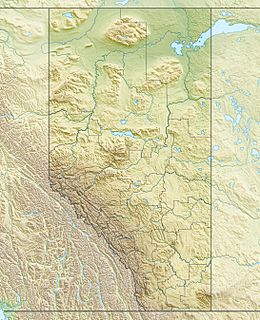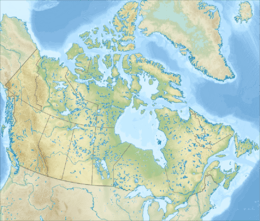Outpost Peak facts for kids
Quick facts for kids Outpost Peak |
|
|---|---|

Outpost Peak seen in front of Mt. Erebus
|
|
| Highest point | |
| Elevation | 2,880 m (9,450 ft) |
| Prominence | 160 m (520 ft) |
| Parent peak | Mount Erebus (3112 m) |
| Listing | Mountains of Alberta |
| Geography | |
| Location | Jasper National Park Alberta, Canada |
| Parent range | Park Ranges Canadian Rockies |
| Topo map | NTS 83D/09 |
| Geology | |
| Age of rock | Cambrian |
| Type of rock | Sedimentary rock |
| Climbing | |
| Easiest route | Mountaineering |
Outpost Peak is a tall mountain in Jasper National Park, Alberta, Canada. It stands about 2,880 meters (9,450 feet) high. This mountain actually has two main tops, or "peaks." One peak is a bit higher than the other.
Outpost Peak is found in a beautiful area called the Tonquin Valley. It's made of sedimentary rock, which means it formed from layers of sand, mud, and tiny bits of ancient sea creatures. These layers were laid down a very, very long time ago during the Cambrian period. Later, huge forces pushed these rocks up and over younger rocks, creating the mountain we see today.
Outpost Peak is close to other famous mountains. Its closest taller neighbor is Mount Erebus, which is about 1 kilometer (0.6 miles) to the south. The Continental Divide, which separates rivers flowing to different oceans, is about 3 kilometers (1.9 miles) to the west. Other nearby peaks include Angle Peak and The Ramparts.
The mountain got its name in 1921 from a survey team. They thought it looked like an "outpost" or a guard tower, fitting with the castle-like shapes of the nearby Ramparts mountains. The name was officially recognized in 1935.
Mountain Weather and Environment
Outpost Peak has a cold climate, typical of northern mountain areas. Winters are very cold and snowy, while summers are mild. Temperatures can drop far below freezing, sometimes feeling like -30 degrees Celsius (-22 degrees Fahrenheit) with the wind.
Because it's so cold, there are small glaciers on the mountain's slopes. These include a small glacier on the north side, the Eremite Glacier on the south, and the Fraser Glacier to the west.
The best time to visit or climb Outpost Peak is usually in July and August. This is when the weather is most pleasant. All the rain and melting snow from Outpost Peak flow into the Astoria River, which then joins the larger Athabasca River.




